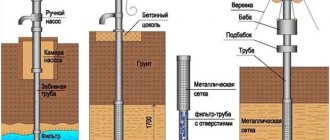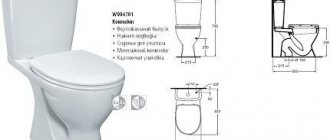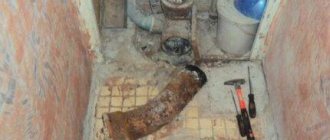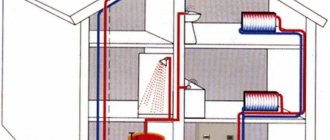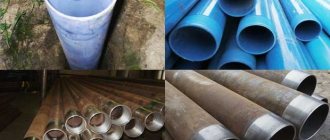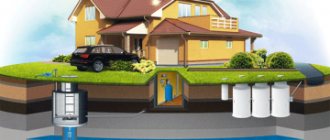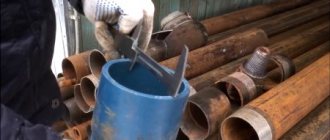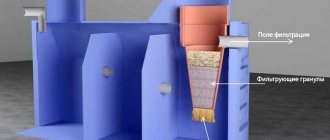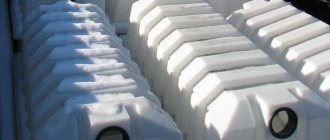To supply water to a private home, you can connect to central networks or install an autonomous source.
Each of these options has limitations in application, positive and negative sides.
Wells are becoming increasingly popular, and more and more often owners of country houses are choosing this water supply option.
Central or autonomous water supply?
Connecting to central networks is convenient for a number of reasons:
- this is easier and cheaper to implement, although permission is required from the organization supplying water and servicing the network;
- water is supplied in unlimited volume , it is usually enough for all distribution points;
- independence from the supply of electricity to the house.
But central water supply is not always available in the private sector. The solution is to establish a local source, which also has some advantages .
- Worn-out urban networks affect water quality
- The central water supply contains residual chlorine.
- Central water treatment plants in some areas cannot cope with water purification.
- In case of accidents or scheduled repairs, the water supply is temporarily interrupted.
- You will have to pay monthly for water supply.
If autonomous water supply is more attractive, all that remains is to decide what it will be - a well or a well.
Documenting
According to Russian legislative law, before implementing a nuclear power plant project, it is necessary to obtain appropriate permission. To do this, you should collect the following package of documents:
- Certificate of ownership of the property (the area where the work will be carried out). If the right of ownership belongs to another person, then a lease agreement is provided.
- Calculation of water consumption approved by employees of the Federal Agency for Water Resources Protection.
- The conclusion received from the Rospotrebnadzor authority that appropriate work can be carried out on the site. According to the requirements of this service, it is necessary to organize security of the area where there will be a water well. The dimensions of such a zone are 60.0x60.0 m; it is prohibited to install any types of structures on the territory. A protective fence must be erected around such an area. In some cases, it is possible to reduce the protected area to 30.0x30.0 m.
- Resolution on design in the subsoil monitoring department.
- Conclusions of geological examination (required for registration).
In addition to the documents provided, you will need to pay tax and obtain a production license, its cost starts from 70 thousand rubles. The amount of payment is affected by the productivity of the plant, for example, if production is carried out on an industrial scale, then the license will increase to 300 thousand rubles (maximum cost). Agree, the price is not small, but if the village is powered by a well, then the cost of a license can be reduced.
Please note that many companies offering NPP installation services help their clients obtain all permits.
Types of wells and their features
There are three types of wells:
- Abyssinian well, or needle well , is an inch pipe that tapers into a filter pipe with a sharp tip. The depth of the source is no more than 12 m, and the surface of the water surface should be no deeper than 8 m due to the capabilities of surface water supply equipment (electric or hand pump). Average productivity – 1 m3.
- A filter well (well in sand) is drilled at a depth of 15 to 50 in the sand layer. Its productivity is up to 1.5 m3/hour. This type of underground source consists of a water supply shaft, which is also a casing pipe, a head, a bottom filter at the lower end of the column, and a deep-well pump.
- An artesian well can produce over 2 m3/hour of water. The aquifer runs at a depth of more than 100 m and is located between 2 layers of rock, usually limestone. The structure consists of a casing, water supply pipes, a deep-well pump and a head.
The right casing for the Moscow region
When developing a well, it is imperative to install casing pipes to strengthen the walls of the bottom. The drill rig passes through loose rocks: clay, loam and sand. Without casing, the walls of the mine will collapse quite quickly.
Boudin is interested: What is better for a well - a casing pipe made of metal or plastic?
The casing ensures the tightness of the shaft. It isolates drinking water from the ground and the ingress of perched water. The sealed column helps the pump create the pressure needed to lift the liquid. The most popular materials for casing are metal, HDPE and uPVC. Let's consider the advantages and disadvantages of each of these materials.
Metal (steel)
Metal is associated with reliability, but in reality it deteriorates faster than plastic. Steel is susceptible to corrosion in humid environments. The rate of metal destruction is 1 mm in 10 years. Often, through corrosion occurs before the artesian rock is exhausted.
Loss of tightness of the casing leads to the fact that the system can no longer be used. It is cheaper to drill a new source than to carry out repairs. When metals corrode, rust is formed, which pollutes the soil in the area and worsens the composition of the liquid.
Figure 4: Metal casing
HDPE
Low-density polyethylene is inferior in strength to uPVC. But this is not its main drawback. Recycled plastic is used to make HDPE. Raw materials for processing may include syringes, canisters, household chemical containers and other dangerous items.
Reprocessing technology does not guarantee complete neutralization of hazardous substances. It is better not to choose HDPE pipes for contact with drinking water.
Figure 5: Metal casing with HDPE pipe inside.
uPVC
We recommend choosing uPVC casing. Standard column diameter in the Moscow region: 125 mm. Advantages of uPVC casing:
- Corrosion resistance: plastic does not rust.
- High strength comparable to the strength of metal.
- Made from safe virgin plastic.
- Resistant to seasonal temperature changes.
- Antibacterial characteristics.
- Simple technology for installing the structure.
- Increased material safety factor.
Installing uPVC extends the life of the well. The casing will remain sealed for at least 50 years. This is approximately how long the artesian source will work.
Figure 6: uPVC casing pipe
Advantages and disadvantages
A well in a private house has pros and cons, which largely depend on the type of source.
But there are also several general advantages :
- protection of water from external influences;
- the productivity is usually sufficient to fully supply water to at least a small house.
Among the disadvantages of wells is noise, but the head is often located outside the house in a special caisson. Even if the source is in the basement, the noise is minimal.
Another disadvantage is the need to purchase additional equipment.
Pros and cons of the Abyssinian well
"Abyssinian" is very simply designed. There are other positive aspects:
- easy installation and dismantling
- the possibility of stuffing into the basement even a finished house;
- service life - on average 15 years , after its completion the structure can be dismantled and moved to another location;
- low cost of arrangement;
- productivity is about 1 m3 per hour, this is enough to service a small country house;
- if a hand pump is used, the water supply does not depend on electricity .
Negative characteristics are:
- impossibility of construction in rock and when the water layer is deeper than 12 m;
- the possibility of contaminants leaking from the surface.
"Gerbil": pros and cons
The productivity of a sand well is usually enough to service a small cottage.
Drilling and installation are carried out quickly. The water is usually of good quality, but there is a possibility of external influence , and in some regions iron levels are recorded in the source.
This source has several more negative characteristics :
- short service life - up to 15 years;
- susceptibility to siltation , especially during idle time;
- the need for annual washing of the bottom filter.
Pros and cons of an artesian well
This source has other advantages.
- Free from pathogens and surface contaminants.
- Long service life.
- Consistency of water supply regardless of season, drought, etc.
But the disadvantages are also quite significant.
- Drilling is carried out only by specialists.
- To carry out work, you must obtain permission; it is also necessary to license the source and enter it into the register.
- High cost of arrangement.
- Water is often characterized by high mineralization, which requires the purchase of a water treatment station.
“Artesian” is the most productive source. It may be enough to provide for a group of cottages and an entire village.
The need for maintenance and arrangement of wells is a common disadvantage
A sand well and an “artesian” are technologically advanced sources of water. When arranging them, in addition to drilling and installing pipes and a pump, you need to take care of several elements.
- To protect the well head and equipment from atmospheric influences, a caisson is needed. This is a sealed container with a bottom hole into which the head fits. Usually the caisson is buried in the ground.
- To reduce the number of pump on and off cycles, it is important to install a hydraulic accumulator . This is a container for collecting liquid. It is installed either in the basement of the house or in a caisson.
- The pump operation is controlled and protected by automation . Its installation and launch is best left to professionals.
The well itself and the equipment need maintenance.
- When debit decreases and sediment appears in the water, the source is cleaned. You can clean the filter well yourself using a vibration pump. An artesian well can be cleaned using various methods, but it is better to leave the procedure to specialists.
- Clean the hydraulic accumulator once a year.
- The deep-well pump and automation are serviced annually, which is best left to the specialists who install the equipment.
- Check the tightness of the joints in the caisson , especially at the point where the head enters the tank.
Read how to choose high-quality filters for well water. What is better, a well or a borehole? The answers are here.
Read in our article why plastic caissons are needed and how to install them correctly.
How to determine the location for a future well?
Theoretically, the speaker can be located anywhere, but when choosing a location, the following factors must be taken into account:
- It is necessary to ensure the possibility of vehicle access to the area where the work will be carried out.
- An area should be designated for the location of the drilling rig and other equipment.
- If you plan to use drilling technology with flushing, you need to prepare conditions for the drainage of technical water.
Drilling with flushing - The well should be located as close as possible to the input; thanks to this, the frontage of excavation work and the length of the pipeline can be significantly reduced, and, consequently, the total cost of the project.
- The place where the work will be carried out must be level, its area is at least 48 m2 (4 by 12 m).
- The facility where work will be carried out must have fencing.
- Electrical wires should not be laid at the drilling site and a 2-meter zone from it.
It is considered correct to arm yourself with a site plan or a topographic map of the area (at most, a hand-drawn diagram), and taking into account the above requirements, choose the most suitable location. If problems arise with this, the specialists of the company that will carry out the work will suggest several optimal options.
Advantages and disadvantages of wells
For a small country house, which is used only in the summer season, a well is often installed.
The positive properties of such a source are:
- simplicity and low cost of installation;
- the ability to manually lift water , which is important in case of power failures;
- ease of maintenance.
But the source also has disadvantages:
- low productivity;
- exposure to external pollutants;
- the complexity of digging and the need to remove soil.
The correct water supply scheme for a private house from a well is here. Find out how to properly arrange the water supply for a private house from a well with your own hands in our article.
Is it possible to equip a well with your own hands, and how to do it on https://klimatlab.com/vodosnabzhenie/kolodcy-i-skvazhiny/dlya-vody-svoimi-rukami.html
List of drilling works
The installation of a power plant can be conventionally divided into the following stages:
- Preparatory. Calculations are made, a project is drawn up, permits are obtained, geological surveys are carried out, etc.
- The process of drilling to a specific limestone horizon.
- AS strengthening (annulus cementing).
- The depth is measured by a level gauge.
- Laying the casing and then checking its integrity.
- Laboratory analysis of water composition.
- Cleaning speakers by pumping.
Pumping is necessary to flush the well - Equipment operation testing.
- An artesian well is integrated into the water supply system.
Features of autonomous water supply systems
Installation and operation of an autonomous home water supply system requires knowledge of several nuances.
- When choosing a pump, it is important to take into account not only the flow rate of the well, but also its depth , the distance from the source to the house and the height of the building.
- The volume of the accumulator depends on the number of water consumers . It is usually calculated that there are 50 liters of water per person.
- Before commissioning a source, it is important to conduct a microbiological and chemical analysis of the water . If necessary, select water treatment equipment.
How deep is an artesian well drilled?
It is impossible to give a monosyllabic answer to this question; it all depends on the nature of the terrain and the depth of the aquifer. Drilling can be carried out both at 30-35 and at 100-150 meters or more. In practice, there have been cases when the limestone horizon was 20 meters from the surface, and vice versa, more than 800. The average depth is about 80 meters.
Without test drilling, the depth of the limestone horizon can be predicted only by indirect evidence, based on information about other wells in the given area.
Please note that the deeper the water is, the higher its mineralization.
Legislative regulations governing water intake
Control over water use lies entirely with the state due to the limited reserves of minerals, the quality and epidemiological situation of the water used. It is extracted using wells from horizons of a certain level. There is no separate article in any normative act on this matter. Most issues related to permitting, obtaining a license, registering a well, etc., are regulated by the following norms and by-laws:
- Law of the Russian Federation “On Subsoil” as amended and supplemented No. 2395−1 of 1992;
- Resolution of the Armed Forces of the Russian Federation “Regulations on the procedure for licensing the use of subsoil”, as amended No. 3314−1 of 1992;
- Instruction of the Committee on Geology and Subsoil Use (Roskomnedra) No. 583 and No. 2395−1 (instructions for the practical implementation of the normative act) of 1994.
Additionally, you should study Art. 7.3 of the Code of Administrative Offences. This document provides for liability for non-compliance with the law on water wells.
Calculators for calculation
Limestone wells are the most expensive. The cost is determined by several factors - the depth of drilling, the diameter of the casing pipes, the brand of pump, the volume of the hydraulic tank, the type of wellhead arrangement (caisson, adapter or simply reinforced concrete rings), the length of the trench before entering the house, transportation costs, etc. The estimated price per linear meter of drilling is from 2000 to 6000 rub.
You can calculate the cost of a deep well taking into account the above characteristics using a special calculator.
Despite the complexity and high cost of design and arrangement, an artesian well is a reliable source of clean, high-quality water for many years to come.
Old-fashioned method - well
A well is a kind of shaft, with an average depth of 10-15 meters, in which water from the nearest aquifer accumulates. The fundamental difference from the well is the diameter - at least a meter. It is thanks to its diameter that the well acquires its main property - it is filled with water. And this water is extracted in different ways - most often in the modern world they use a pump that supplies it to the mountain, but the old-fashioned turntable with a chain and bucket also has a right to exist (however, now such exotic equipment is practically not used).
The well shaft is equipped with concrete rings with a groove connection or smooth walls. The tightness of the well will depend on how well the joints are closed. Moreover, this applies to both the inlet of water into the mine and the flow out of it. Sometimes a concrete shaft is made monolithic - as a rule, such reinforced rings are cast from above as they are dug. By the way, here lies another difference between a well and a well - a well is drilled, and a well is dug (less often, if you suddenly decide to build on a rock, it is hollowed out or knocked out).
